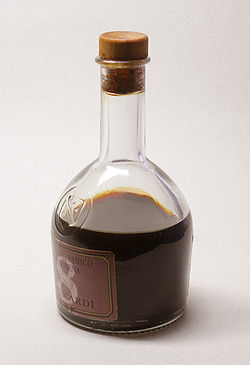In earlier days, I'd bring bread home, warm it up and slather it with butter. But my favorite way to eat it these days is to pour a little olive oil and a little balsamic vinegar on a plate and dip away. There is nothing so tasty, except maybe if you add some fresh, ripe tomatoes to the mix.
For something that I love so much, I know very little about balsamic vinegar. Except that the more expensive it is, the better it is. The 8.5 oz. bottle I have in my cupboard now cost about eight dollars, which is low-priced in the world of balsamic, but about all my budget can tolerate.
The word balsamico (from Latin balsamum, from Greek balsamon) means "balsam-like" in the sense of "restorative" or "curative". The balsam tree had medicinal purposes in ancient times. The original traditional product (Aceto Balsamico Tradizionale) is made from a reduction of cooked white Trebbiano grape juice and is not a vinegar in the usual sense. This product has been made in the Modena and Reggio Emilia regions of Italy since the Middle Ages. The names "Aceto Balsamico Tradizionale di Modena" (Traditional Balsamic Vinegar of Modena) and "Aceto Balsamico Tradizionale di Reggio Emilia" (Traditional Balsamic Vinegar of Reggio Emilia) are protected by both the Italian government and the European Union. Balsamic Vinegar of Modena (Aceto Balsamico di Modena), a less expensive imitation of the traditional product, is today widely available and much better known.
When choosing the balsamic vinegar, you have to read the label carefully. True, traditional (tradizionale) balsamic vinegar is made from crushed grapes that have been aged for at least 12 years and has a thick, rich and slightly sweet flavor. The second type of balsamic vinegar (no tradizionale on the label) is a more commercial version made from wine vinegar; it has additives such as food coloring, sweeteners and preservatives . The flavor of the imitation balsamic is similar, but not really the same as the "tradizionale" variety. Thus the difference in price. Twelve years in casks or a few months processed in a factory. So the key is to look for the traditional kind and buy the best you can afford.

No comments:
Post a Comment